Venus, the brilliant Evening Star, will move past the Pleiades star cluster in early April. This is a zoomed-in view on April 3, looking fairly high in the western sky at nightfall. Binoculars will reveal many of the cluster's stars.
You are here
Venus and the Pleiades
Two of the great beauties of the night sky, Venus and the Pleiades, will slide past each other the next few nights. Venus is the brilliant “evening star,” high in the west at nightfall. The Pleiades is a star cluster that forms a tiny dipper. It’s above Venus this evening. But Venus will stand directly beside the cluster’s brightest star tomorrow night.
Astronomers can tell you the distance to Venus to within a few miles. But the Pleiades is another story. Different studies over the last couple of decades, using different techniques and equipment, have yielded estimates that vary by about 50 light-years.
For a long time, most estimates said the distance was about 440 light-years. But a space telescope designed to make the most accurate measurements up to that time disagreed. It came up with a distance of only 390 light-years. Astronomers recalibrated the satellite’s observations a few years later and came up with a slightly greater distance.
A new and more accurate space telescope is measuring stellar distances even now. Its early look at the Pleiades puts the cluster back in the range of 440 light-years — just as it was before space telescopes.
The difference doesn’t mean much to casual skywatchers. But it’s crucial to astronomers. They use clusters like the Pleiades to study how stars evolve. To do so, they need to know how far away the stars are, which reveals how bright they are — a key measurement in understanding the stars.
Script by Damond Benningfield
Get Premium Audio
Listen to today's episode of StarDate on the web the same day it airs in high-quality streaming audio without any extra ads or announcements. Choose a $8 one-month pass, or listen every day for a year for just $30.




